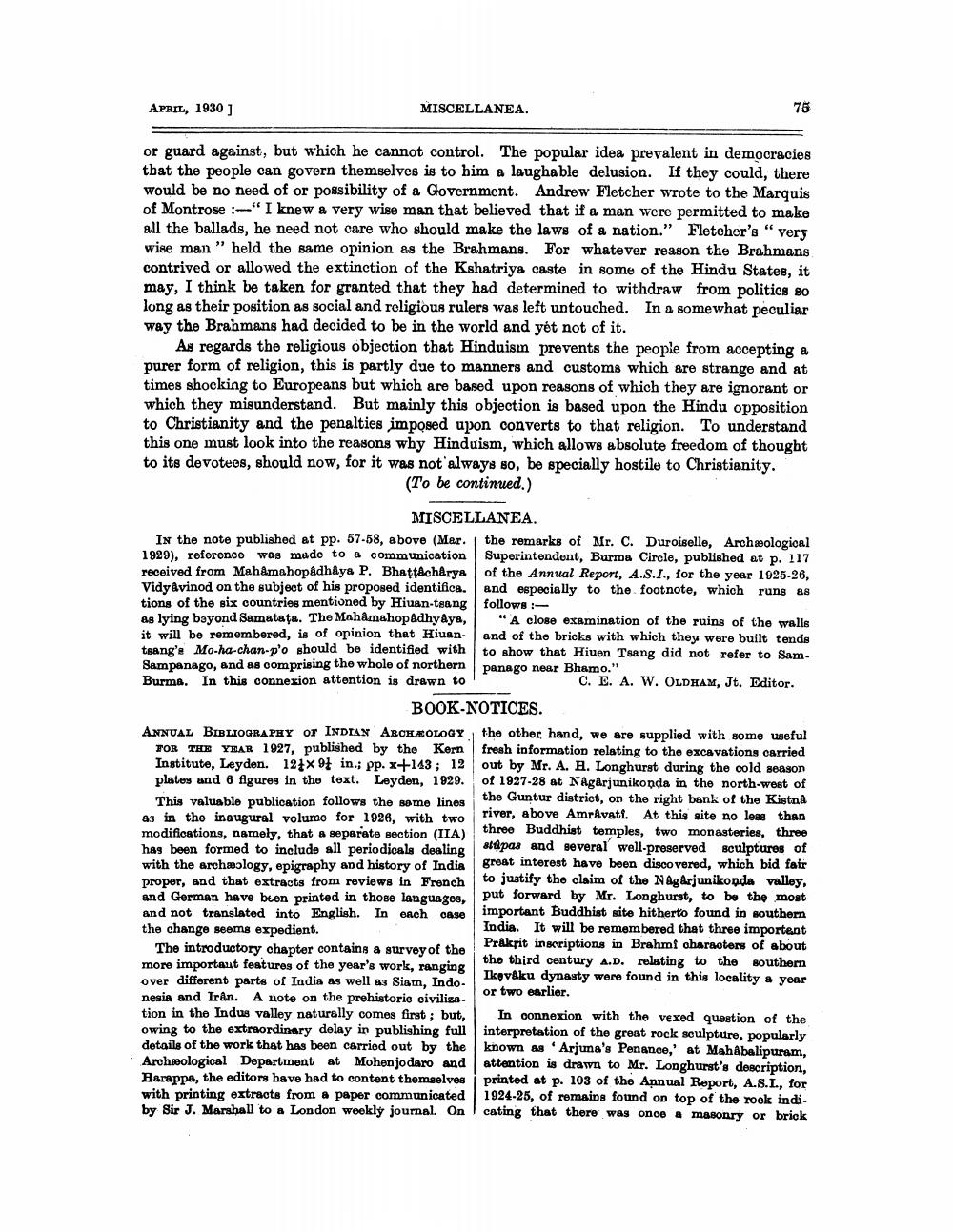________________
APRIL, 1930 ]
MISCELLANEA.
76
or guard against, but which he cannot control. The popular idea prevalent in democracies tbat the people can govern themselves is to him a laughable delusion. If they could, there would be no need of or possibility of a Government. Andrew Fletcher wrote to the Marquis of Montrose -"I knew a very wise man that believed that if a man were permitted to make all the ballads, he need not care who should make the laws of a nation.” Fletcher's" vers wise man" held the same opinion as the Brahmans. For whatever reason the Brahmans contrived or allowed the extinction of the Kshatriya caste in some of the Hindu States, it may, I think be taken for granted that they had determined to withdraw from politics so long as their position as social and religious rulers was left untouched. In a somewhat peculiar way the Brahmans had decided to be in the world and yet not of it.
As regards the religious objection that Hinduism prevents the people from accepting a purer form of religion, this is partly due to manners and customs which are strange and at times shocking to Europeans but which are based upon reasons of which they are ignorant or which they misunderstand. But mainly this objection is based upon the Hindu opposition to Christianity and the penalties imposed upon converts to that religion. To understand this one must look into the reasons why Hinduism, which allows absolute freedom of thought to its devotees, should now, for it was not always so, be specially hostile to Christianity.
(To be continued.)
MISCELLANEA. In the note published at pp. 57-58, above (Mar. the remarks of Mr. C. Duroiselle, Archeological 1929), reference was made to a communication Superintendent, Burma Circle, published at p. 117 received from Mahamahopadhaya P. Bhattacharya of the Annual Report, A.S.I., for the year 1925-26, Vidyâvinod on the subject of his proposed identifica. and especially to the footnote, which runs as tions of the six countries mentioned by Hiuan-tsang follows: As lying beyond Samatata. The Mahamahopadhyâya, "A close examination of the ruins of the walls it will be remembered, is of opinion that Hiuan- and of the bricks with which they were built tends tang's Mocha-chan-p'o ghould be identified with to show that Hiuen Tsang did not refer to Sam. Sampanago, and as oomprising the whole of northern panago near Bhsmo. Burma. In this connexion attention is drawn to
C. E. A. W. OLDHAM, Jt. Editor.
BOOK-NOTICES. ANNUAL BIBLIOGRAPHY OF INDIAN ARCHÆOLOGY, the other hand, we are supplied with some useful
TOR THE YHAR 1927, published by the Kern fresh information relating to the excavations carried Institute, Leyden. 12+94 in.; pp. x+143 ; 12 out by Mr. A. H. Longhurst during the cold season plates and 6 figures in the text. Leyden, 1929. of 1927-28 at NAgârjunikonda in the north-west of This valuable publication follows the same lines
the Guntur district, on the right bank of the Kistna &3 in the inaugural volume for 1926, with two
river, above Amråvati. At this site no less than modifications, namely, that a separate section (IIA)
three Buddhist temples, two monasteries, three has been formed to include all periodicals dealing
stupas and several well-preserved sculptures of with the archæology, epigraphy and history of India
great interest have been discovered, which bid fair proper, and that extracts from reviews in French to justify the claim of the Nagarjunikonda valley, and German have been printed in those languages,
put forward by Mr. Longhurst, to be the most and not translated into English. In orch case important Buddhist site hitherto found in southern the change seems expedient.
India. It will be remembered that three importent The introductory chapter contains a survey of the
Prakrit inscriptions in Brahmi obaracters of about more important features of the year's work, ranging
the third century A.D. relating to the southern over different parts of India as well as Siam, Indo
Ikpváku dynasty were found in this locality a year
or two earlier. nesia and Irán. A note on the prehistorio civilization in the Indus valley naturally comes first; but, In connexion with the vexed question of the owing to the extraordinary delay in publishing full interpretation of the great rock sculpture, popularly details of the work that has been carried out by the known M'Arjuna's Penance,' at MahAbalipuram, Archeological Department at Mohenjodaro and attention is drawn to Mr. Longhurst's description, Harappa, the editors have had to content themselves i printod at p. 103 of the Annual Report, A.S.L., for with printing extracts from a paper communicated 1924-25, of remains found on top of the rock indiby Sir J. Marshall to a London weekly joumal. Oncating that there was once a masonry or brick




